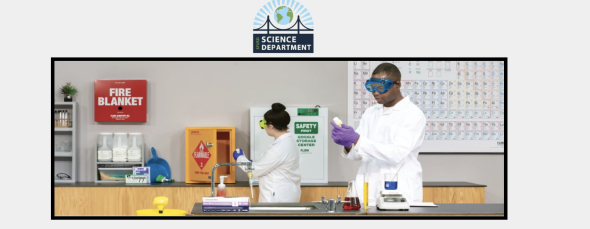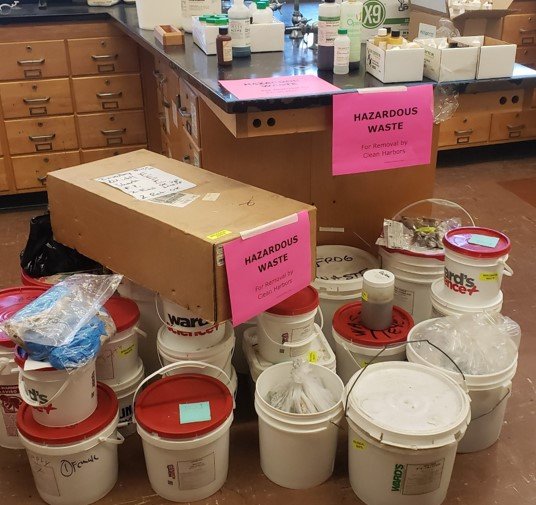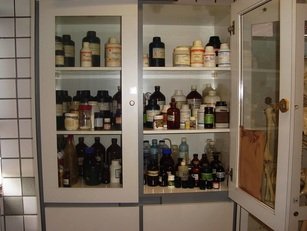2025- 2026 Safety Training Information
Link to this section

Secondary Science Safety Training
Please be on the lookout for an email from ASCIP on Thursday, August 14, 2025, regarding our Annual Safety Training, which will be conducted asynchronously for all secondary science teachers.
Please read the flyer below for helpful tips and information on navigating the Safety Training.
Annual Safety Training Link to this section
We ask that all science teachers complete a laboratory equipment survey to document the status of their classrooms.
- For MS teachers: http://tinyurl.com/sf-ms-equip
- For HS teachers: http://tinyurl.com/sf-hs-equip
Teacher Safety Documents for Students and Families Link to this section
Quarterly Self-Inspection Checklists, Waste Disposal, and Chemical Inventory
Link to this section
Please see the Science Safety Quick Links page for an easy reminder of upcoming tasks.
Science Quarterly Self-Inspection Checklist (Due Quarterly)
SFUSD Facilities Department introduced on January 2025 of a new mandate from the San Francisco Department of Public Health that each site (that houses chemicals) must complete the SFUSD Science Quarterly Self-Inspection Checklist to High School Department Chairs and Middle School Teacher Leaders.
- Quarter 1 is due: Week before March 31
- Quarter 2: N/A due to summer
- Quarter 3 is due: Week before September 30
- Quarter 4 is due: First week of December
General Guidance:
- Instructions: Check out how to submit a Science Quarterly Self-Inspection Checklist.
- Frequently asked questions: At our January 2025 HS Science Dept. Chair and MS Science Teacher Leader meeting, we gathered questions that pertain to all sites. If you have any questions, first see Science Quarterly Self Inspection Checklist FAQs or email Priscilla Perez- Science Safety Coordinator |Science Dept. (perezp2@sfusd.edu) and Janette Chieng- Sr Management Assistant |Facilities Dept (chiengj@sfusd.edu).
Hazardous Waste Pickups (Due Fall and Spring Semester)

High School Department Chairs and Middle School Teacher Leaders have been notified of our upcoming waste pickups (3 this year).
- Fall Break 2025, will be our first waste pickup of the school year. Please sign off by November 14th, 2025, to indicate that your request is ready for pickup.
- Winter Break 2025 will be our second waste pickup of the school year. If your site waste wasn't picked up during the Fall break, it will be picked up during winter break, with a sign-off deadline of December 12th, 2025.
- Summer 2026 will be our last waste pickup of the school year. Please sign off by May 22, 2026, that your request is ready.
Once you gather new waste, check out how to submit a hazardous waste pick-up form. To request labels and/or containers for waste, please fill out this request form.
General Guidance:
- Length and quantities: According to CalOSHA and DPH, school sites must not accumulate waste for more than 6 months. Please make sure to submit pickups each time you are asked. Avoid waiting if you have waste. Total quantities should not exceed 55 gallons.
- Labeling: For waste generated during labs, use a white label and make sure to include a generation date and any hazards.
- Chemical Sweeps: If you are using the "dot system," you will be able to look at your shelves and easily see which chemicals are no longer being used. In addition, any lab waste created during the year will also need to be added to the pickup request. Please label, set-aside, and submit the form for any known and unknown chemicals that are surplus, unused, or expired. Make sure that when chemicals are set aside as waste that they continue to be kept by compatibility.
- Avoid unknowns: The best way to avoid generating unknown waste is to label your containers when the lab waste is created. Include the date, reactants, and product on the label. A pink chemical waste sticker also goes on the container. If you need these labels, check with your department chair or please fill out this request form.
- Storage: Make sure waste is stored according to compatibility, just like your ongoing inventory.
If you have unknown waste, follow the above procedure with as much information as you can.
Disposing of biological waste
- Microbial specimens in petri dishes need to be sterilized using an autoclave or bleach. They are then disposed of in the regular trash. You will follow the hazardous waste procedures above for disposal of the bleach.
- When you receive a shipment of specimens, be sure to look at the SDS so you know what was used to preserve the specimens. If it includes formalin, you will follow the hazardous waste procedures above for disposal.
- For larger specimens and other waste from dissection labs see these instructions for how to bag and dispose of bio waste. If you need bags, please fill out this request form.
- If you have old biological specimens that may have been preserved in formaldehyde, use the instructions for how to inventory biological specimens. It is not recommended that you continue to keep specimens preserved in formaldehyde. These specimens need to be included in the chemical waste pick-up request. Leave them in the containers and list on the waste removal form.
Chemical Inventory and Storage (Due Annually by May 15th)

We are required by the state (OSHA and DPH) to report site-specific chemical inventory annually. Please follow the Instructions to complete site inventory by May 15th.
Chemical Storage: Chemicals need to be stored in such a way that like substances are stored together and those that could potentially interact with each other are kept separately. Some chemicals need to be stored in flammables or corrosives cabinets. See this more detailed guidance for chemical storage.
Chemical Sweeps: The inventory update provides a great opportunity for school sites to turn unwanted items into waste. See the instructions for the form you need to fill out with your request for a waste pickup.
Return to Employee Pages Link to this section
This page was last updated on October 7, 2025



